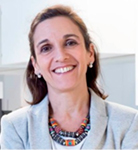
After blood, bone is the most frequently implanted/ transplanted tissue, with about 2 million bone grafts performed each year worldwide – a number that tends to increase at the rate of population aging. A well-known case is that of the jaw graft to allow firmer dental implants. However, many other causes, such as tumors, severe fractures, congenital malformations or even infections, may cause a patient to need a graft, that is to say, an implant of a natural or synthetic piece of bone to support the natural growth of bone tissue.
In Barcelona, at the Universitat Politècnica de Catalunya (UPC), a research group has been successfully working on the development of innovative tissue regeneration biomaterials. Led by Professor Maria-Pau Ginebra, the multidisciplinary group consists of 30 researchers. After many published papers and patents obtained, Professor Ginebra decided to found, along with other members of the group, a spin-off company to bring the results of years of research into real life. Thus, in 2013, Mimetis Biomaterials was created, dedicated to nature-inspired bone regeneration solutions.
On the afternoon of September 24, Prof. Maria-Pau Ginebra will deliver a plenary lecture at the XVIII B-MRS Meeting. She will talk about a new generation of bone graft biomaterials, made through nature-inspired methods that allow control of the structure and composition of the material at the nano scale. The resulting biomaterials bring together the benefits of both natural and artificial bones, including the possibility of producing personalized grafts on 3D printers.
See our mini-interview with this Spanish scientist, Full Professor and Head of the Department of Materials Science and Metallurgy at UPC, President of Mimetis Biomaterials, and Member of the Editorial Board of Acta Biomaterialia, Journal of Tissue Engineering and the International Journal of Molecular Sciences.
B-MRS Newsletter: – You work in a research area that has a direct impact on society. What, in your opinion, is your scientific discovery with the greatest actual or potential impact? Please describe it very briefly.
One of the great challenges in the field of bone regeneration is the development of synthetic materials that are able to be degraded and transformed in newly formed bone. In this case, the synchronization between material degradation and new bone deposition is critical, and very difficult to achieve. We have demonstrated that this can be accomplished by using biomimetic processing routes, which allow tuning the nanostructure and composition of hydroxyapatite, mimicking more closely the mineral phase of bone. In this way the synthetic material can enter the natural bone remodeling cycle, allowing for this progressive transformation in new bone tissue.
B-MRS Newsletter: – Turning scientific knowledge into products is not an easy task. In your experience, what are the most important factors in getting a lab research to become a product on the market?
The transformation of the scientific achievements into real products is indeed a great challenge. This is particularly difficult in the biomedical field, where the scientists face a number of regulatory restrictions which were often overlooked during the previous stages of more “academic” research. In my experience, to be successful, you need the confluence of a good idea and the right people. Moreover, you need money. In summary, in my experience there are three main aspects that determine the success of the translation of a good idea to the market: 1) selecting a good team, with people mastering the different aspects of entrepreneurship, which we, as scientist, do not know; from regulation/legislation to marketing and financial aspects; 2) finding appropriate investors is always necessary; the innovation in the biomedical field is particularly expensive; 3) being willing to work really hard.
For more information on this speaker and the plenary talk she will deliver at the XVIII B-MRS Meeting, click on the speaker’s photo and the title of the lecture here https://www.sbpmat.org.br/18encontro/#lectures.
